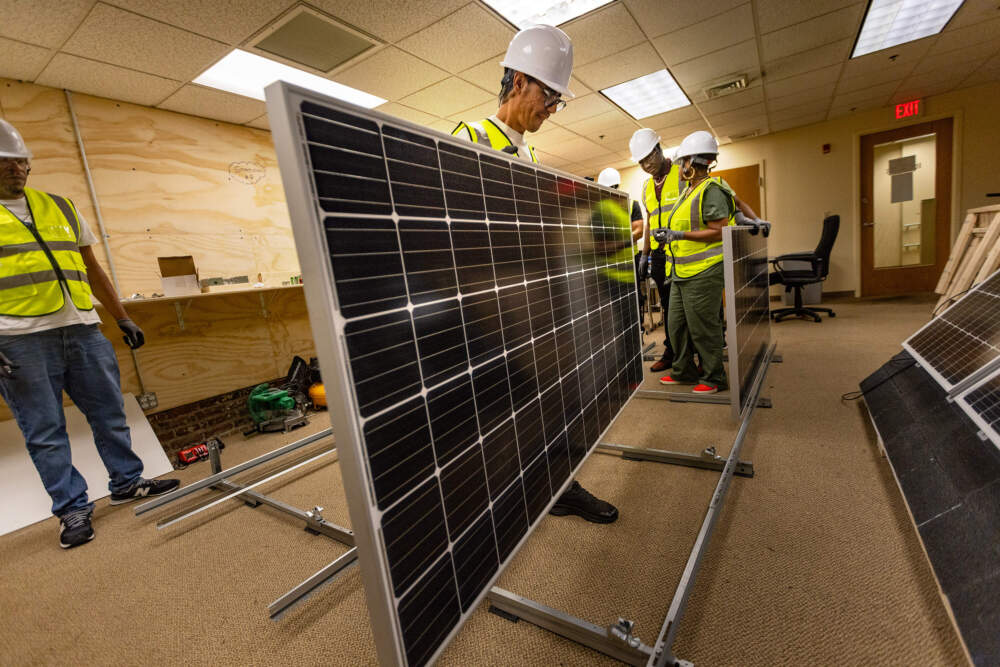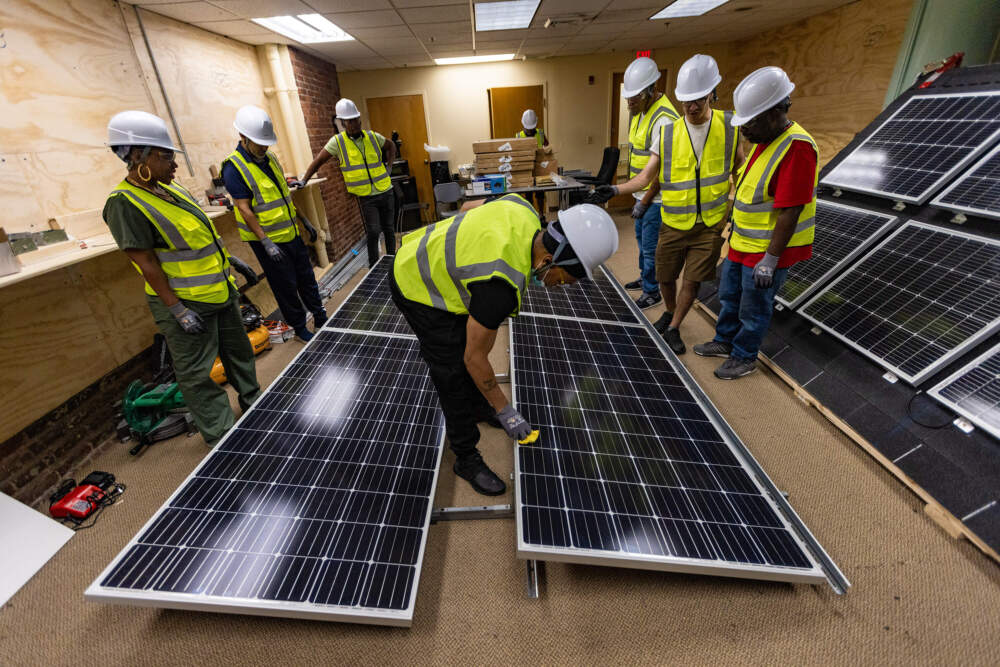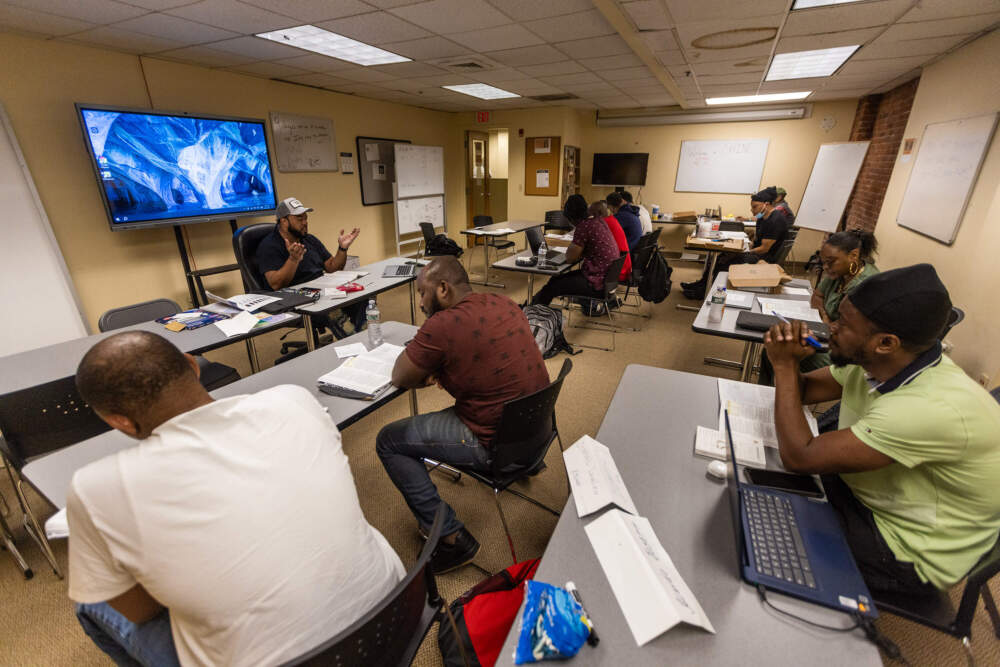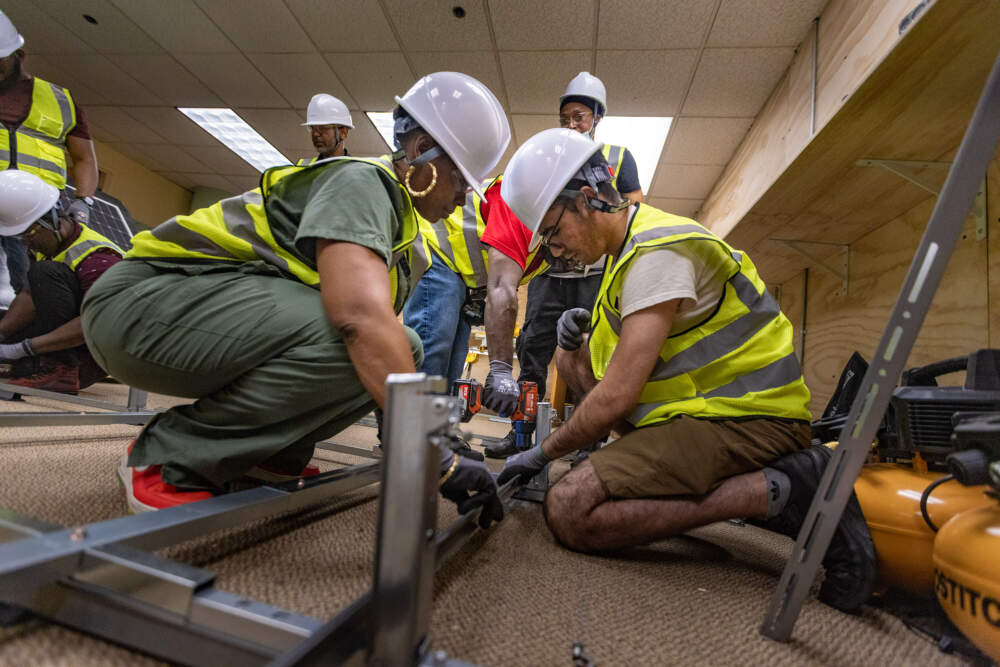 Timothy Edwards uses a power drill to fasten the array frame together as Narkeisha Gilbert and Lhoucine Bouhaddou hold it in place during the solar technician training class. (Jesse Costa/WBUR)
Timothy Edwards uses a power drill to fasten the array frame together as Narkeisha Gilbert and Lhoucine Bouhaddou hold it in place during the solar technician training class. (Jesse Costa/WBUR)
Instructor Carlos Antunes watched as his students, wielding power drills and socket wrenches, assembled metal racks on the floor, then mounted four large solar panels on them.
“Don’t forget your points where your north and south are gonna be,” he said.
Even though the class was held in a carpeted basement close to Boston’s Chinatown, the 10 adults wore hard hats, safety goggles and fluorescent yellow vests.
The students were training to become solar technicians — workers who set up, maintain and repair solar panels.

The course is part of SHINE, the Solar Helping Ignite Neighborhood Economies program. It’s an initiative of the global environmental and social change nonprofit Rare. Organizers said the program’s goal is to tackle poverty through clean-energy-centered climate action. They’ve focused their efforts on people of color from city neighborhoods that carry disproportionately high environmental burdens but have been under-represented in the green economy.
Rashawn Skinner of Roxbury is one of the students training to work in the solar field.
“This is the new wave — the new, you know, wave of the future,” the 46-year-old said. “[Solar power is] clean, you’re saving the environment, and you’re also helping out the community. And I’d love to be a part of that.”

Massachusetts needs a lot more solar power in order to become carbon neutral by the year 2050, according to state officials. The state currently has about five gigawatts of solar capacity but needs approximately 30 gigawatts to meet that goal. It won’t hit the target unless it ramps up the annual rate of solar installations.
The economic development agency Massachusetts Clean Energy Center, which has helped fund SHINE, said in a 2023 report that the state needs about 4,000 additional solar workers by 2030, out of approximately 30,000 new clean energy workers overall.
“We need everybody to participate in the clean energy workforce and in the solar workforce,” said Frank Lowenstein, an advisor for Rare who led the organization’s Boston efforts until last month. “What’s more, having a more diverse workforce means that if you’re marketing solar, you can be marketing solar to the community with people from the community.”
MassCEC doesn’t track data on diversity in the overall solar workforce in Massachusetts. A report from the Interstate Renewable Energy Council says nationally, about 70% of people in the solar workforce are white men.

The solar training classes are held inside a building operated by Action for Boston Community Development, or ABCD. The nonprofit has partnered with Rare to run the course and provide support services to students and graduates, including job search assistance.
Ron Marlow, vice president of workforce development and alternative education at ABCD, said this is the perfect time to bring more people from under-resourced communities into the solar field.
“In many instances, low-income individuals, people of color, have entered occupations as those occupations were mature and/or dying, which meant that there were no bridges to the future,” Marlow said. “Being able to come in an industry that is growing and anticipated to grow significantly over the next 10 years … proves that, you know what? People care about individuals who live in these communities and are trying to give them bridges…”
The course is free, and participants receive a stipend.
Student Narkeisha Gilbert of Dorchester said she’s going to talk up solar technology to everyone once she becomes a technician.
“I like the difference of having energy from a solar panel. It don’t have to be from Eversource,” Gilbert said, adding that she wants it to be more accessible. “I wish you don’t have to have to own your own house (to have solar panels). So I’m, in my way, trying to make it so everyone can have it. It don’t have to be just a homeowner.”

In another component of the SHINE program, organizers will help nonprofits and local businesses in under-resourced neighborhoods get solar panels installed on their rooftops. Nearby residents with low incomes will have the opportunity to access some power from those solar arrays as well, according to program organizers.
The 13-week, 450-hour course features classroom instruction with lots of science, math and technical reading. After the six-hour class each day, Skinner heads to his job transporting medical equipment at Boston Children’s Hospital. The single dad said he hopes completing the course sets an example for his teenaged son.
“It’s more of a career path and not just the job. … You can be a tech, you can be a salesperson, you can be behind the scenes, planning the arrays and the designs that’s going to go onto the buildings,” Skinner said. “[My son] sees dad doing it, and it kind of inspires him to keep on the right path and doing what he needs to do.”
Skinner said maybe his son’s path will include a career in solar, too. That’s exactly what the program’s organizers like to hear. They said their students, the first group of whom finish the course this week, will be the best recruiters to help diversify the field.